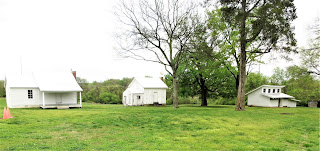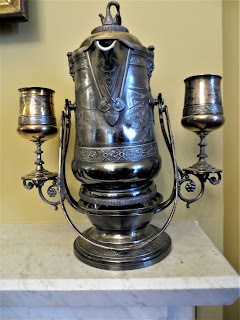This is Part 2 of our Nashville "What's Out There Weekend" put on by The Cultural Landscape Foundation (tclf.org).
From our morning Music Row tour, we high-tailed it to our Clover Bottom Farm tour. We needn't have hurried because our guide was late. We had time to roam around the outside of the mansion, read the main historical marker, and take photos. A light rain was falling making retrieval of the umbrella from the car prudent. (I don't like getting wet!)
 |
| Clover Bottom Farm's Italianate-style mansion. |
The mansion was not built until 1859 and was the cornerstone of the 1,500-acre Clover Bottom Plantation. It was built near Nashville's first horseracing track. The mansion was occupied at different times by soldiers from both armies of the Civil War. From 1898 on, thoroughbred horses were raised at the plantation.
The main historical marker told of a young slave who lived at Clover Bottom. His name was John McCline and he wrote an autobiography, "Slavery in the Clover Bottoms," which provided a rare look at the life of a slave prior to and during the early years of the Civil War.
 |
| John McCline's story. |
 |
| Two slave cabins and a chicken house (right). |
 |
| The carriage house and thoroughbred barn. |
 |
| A wild hen turkey came to see what the fuss was about. |
 |
| Close up of one of the slave cabins. |
 |
| The cellar of the cabin with hand-hewn stone steps. |
 |
| The interior of the cabin still sported some original wall covering. |
 |
| The wood on the side of the cabin is hand-hewn. You can tell by the pattern left in the wood. |
 |
| A circular saw left this pattern on the upright wood. |
 |
| The chicken house. |
 |
| The transverse-crib thoroughbred barn. |
 |
| The transverse-crib thoroughbred barn. |
Today, we were allowed to go into the mansion. Here are a few impressions:
 |
| Bob by the grand staircase. |
 |
| Second-floor door to a balcony. |
 |
| An old samovar. |
 |
| Original light fixture. |
 |
| A very unique red window. |
 |
| View from the front porch. |
The Hermitage was Andrew Jackson's retreat and cotton plantation. Our guide was waiting for us in front of the gift shop.
 |
| Our TCLF guide is on the right. |
Our walking tour started with us working our way across beautiful green lawns to the First Hermitage. This is where Andrew Jackson and his family lived while the mansion was being constructed. Our first stop was at The Spring House which supplied fresh water for the plantation. It used to be an outdoor spring but in order to protect it, a building was put up around it.
 |
| Plantation trees in rows. |
 |
| Looking toward the First Hermitage. |
 |
| The Spring House |
 |
| The importance of water in any landscape. |
Then he bought the neighboring farm and called it The Hermitage, meaning retreat. His new farm included a two-story log farmhouse. By 1806, workers had added a two-room log kitchen and quarters for some of his nine slaves just a few yards from Jackson's home. Work commenced on a new brick mansion which they moved into in 1821. (His "farm" was actually a 1,000-acre plantation.)
 |
| The First Hermitage. |
 |
| The newer Hermitage grand entrance. |
 |
| The back of The Hermitage. |
The cotton fields would only be partially planted and then one section would be allowed to lay fallow. Then another section would be planted in cotton. In order to make his farm more self-sufficient and more profitable, The Hermitage had its own baling machine, and cotton gin and press built by Andrew Jackson.
 |
| Cotton fields. |
"Cotton grew best in a broad swath of land across South Carolina, Georgia, Alabama, Mississippi, Louisiana, and Texas, land largely occupied by Indians. As white settlers pushed west, their hunger for more land led to armed conflict with the Indians. The Indian Removal Act of 1830, which Jackson essentially authored, forcibly removed Indians from their land in the late 1830s."
"Cotton provided Jackson's profit. However, pork and approximately 300 acres of corn, raised and processed by enslaved hands, sustained the diet of everyone at The Hermitage. Jackson's enslaved laborers also planted, tended, and harvested a diversity of crops that fed animals and produced supplies for the plantation. These included wheat, millet, oats, sorghum, and hemp."
While we walked around the perimeter of the plantation house, we saw a herd of Belted Galloways, a Scottish heirloom breed of beef cattle. They "would not have had this particular breed" when Andrew Jackson lived here, but they did have other livestock. "It is recorded in one year that he had 300 hogs, 60 cows and yearlings, 22 calves, nine sheep, and 59 lambs. It is believed that the cattle were Herefords or Durhams."
The information board on the Belted Galloway is quite interesting.
 |
| A current photo of a Belted Galloway at The Hermitage. |
 |
| The front gates. |
 |
| The long drive up to the front of the mansion. |
 |
| The Hermitage - people waiting to go in for a tour of the mansion. |
(To be continued in Part 3...)




No comments:
Post a Comment
Please let me know what you think, your experiences, and constructive criticism to make this blog stronger.